Wave of violence across the oPt and Israel results in record casualties
Alarming attacks on Israelis and Palestinians and concern over excessive use of force by Israeli forces
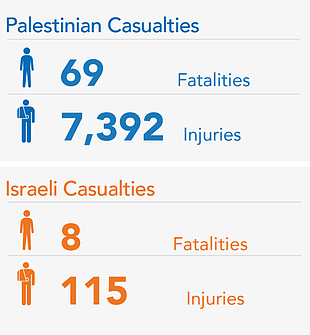 The Palestinian protests and confrontations with Israeli police that began in mid-September in the Haram Al Sharif/Temple Mount in East Jerusalem’s Old City,[1] rapidly spread throughout the oPt, including all parts of the West Bank and the Gaza-Israel border areas. What followed in October was a wave of violence characterized by demonstrations, violent clashes, and deliberate attacks against civilians that, by the end of the month, left 69 Palestinians and eight Israelis dead and more than 7,300 Palestinians and 115 Israelis[2] injured.
The Palestinian protests and confrontations with Israeli police that began in mid-September in the Haram Al Sharif/Temple Mount in East Jerusalem’s Old City,[1] rapidly spread throughout the oPt, including all parts of the West Bank and the Gaza-Israel border areas. What followed in October was a wave of violence characterized by demonstrations, violent clashes, and deliberate attacks against civilians that, by the end of the month, left 69 Palestinians and eight Israelis dead and more than 7,300 Palestinians and 115 Israelis[2] injured.
The number of casualties among West Bank Palestinians in October is the highest recorded in a single month since OCHA began monitoring and reporting on conflict-related casualties in 2005, while the number of casualties in the Gaza Strip is the highest since the end of the 2014 armed conflict.
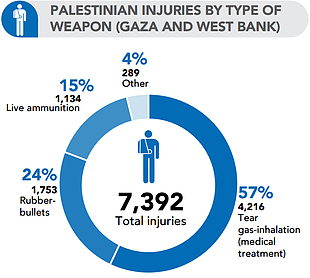 The violence escalated from 1 October, when an Israeli settler couple in Nablus governorate was shot and killed by a group of armed Palestinians, reportedly affiliated with Hamas. This marked the beginning of a series of attacks, mostly stabbings, by Palestinian individuals not affiliated with any particular faction, but acting on their own to target Israeli forces and civilians in both the West Bank and Israel. The attacks claimed the lives of eight Israelis and resulted in the injury over 55 others, including four children. As a result of this type of incident, 40 Palestinian perpetrators and alleged perpetrators, including ten children, were killed and another four were injured. The circumstances surrounding some of the incidents remain disputed, including claims that some of those implicated did not actually carry out an attack.
The violence escalated from 1 October, when an Israeli settler couple in Nablus governorate was shot and killed by a group of armed Palestinians, reportedly affiliated with Hamas. This marked the beginning of a series of attacks, mostly stabbings, by Palestinian individuals not affiliated with any particular faction, but acting on their own to target Israeli forces and civilians in both the West Bank and Israel. The attacks claimed the lives of eight Israelis and resulted in the injury over 55 others, including four children. As a result of this type of incident, 40 Palestinian perpetrators and alleged perpetrators, including ten children, were killed and another four were injured. The circumstances surrounding some of the incidents remain disputed, including claims that some of those implicated did not actually carry out an attack.
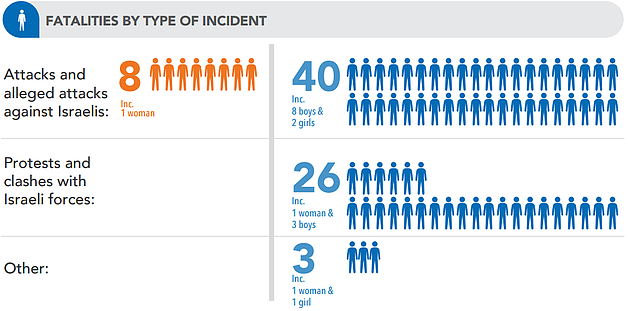
Widespread protests and clashes took place between Palestinians and Israeli forces across the West Bank, particularly at checkpoints and during search and arrest operations. Protests then spread to areas next to the Israeli perimeter fence surrounding the Gaza Strip, resulting in several breaches of the fence. The highest number of casualties recorded was in Jerusalem governorate (see info-graphic herein), where more than 1,300 Palestinians were injured, the majority in East Jerusalem (mainly Al 'Isawiya, Shu'fat refugee camp and the Old City).
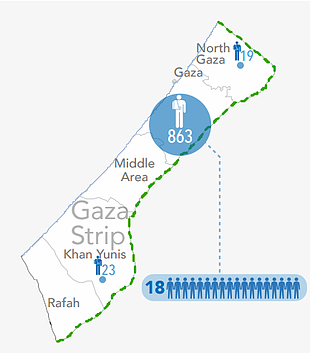 The majority of Palestinian injuries (approximately 57 per cent) as well as three fatalities (including one eight-month-old infant) resulted from tear gas inhalation requiring medical treatment. The second largest category of injury to Palestinians (24 per cent) was from rubber bullets. Finally, 15 per cent of injuries were from live ammunition shot by Israeli forces—more than 1,100 Palestinians—the highest that OCHA has recorded in a given month since 2005. Over 100 of the live ammunition injuries were recorded in three incidents that took place in a single day (11 October) in the northern West Bank: at the checkpoints of Huwwara (Nablus), Tulkarm (Tulkarm), and Qalqiliya city (Qalqiliya).
The majority of Palestinian injuries (approximately 57 per cent) as well as three fatalities (including one eight-month-old infant) resulted from tear gas inhalation requiring medical treatment. The second largest category of injury to Palestinians (24 per cent) was from rubber bullets. Finally, 15 per cent of injuries were from live ammunition shot by Israeli forces—more than 1,100 Palestinians—the highest that OCHA has recorded in a given month since 2005. Over 100 of the live ammunition injuries were recorded in three incidents that took place in a single day (11 October) in the northern West Bank: at the checkpoints of Huwwara (Nablus), Tulkarm (Tulkarm), and Qalqiliya city (Qalqiliya).
In addition to Israeli casualties killed or injured as a result of stabbing attacks in October there were 52 Israelis, including 24 civilians and 28 members of security forces, injured in clashes and other incidents, including 45 as a result of stone throwing, two from Molotov cocktails, three from pipe bombs, and one as a result of vehicle ramming. The highest number of Israeli injuries were in East Jerusalem (33 per cent), followed by the governorates of Hebron (21 per cent), Nablus (13 per cent), Ramallah (11 per cent), Bethlehem (7 per cent), and Salfit, Qalqilya and within West Jerusalem (one injury each).
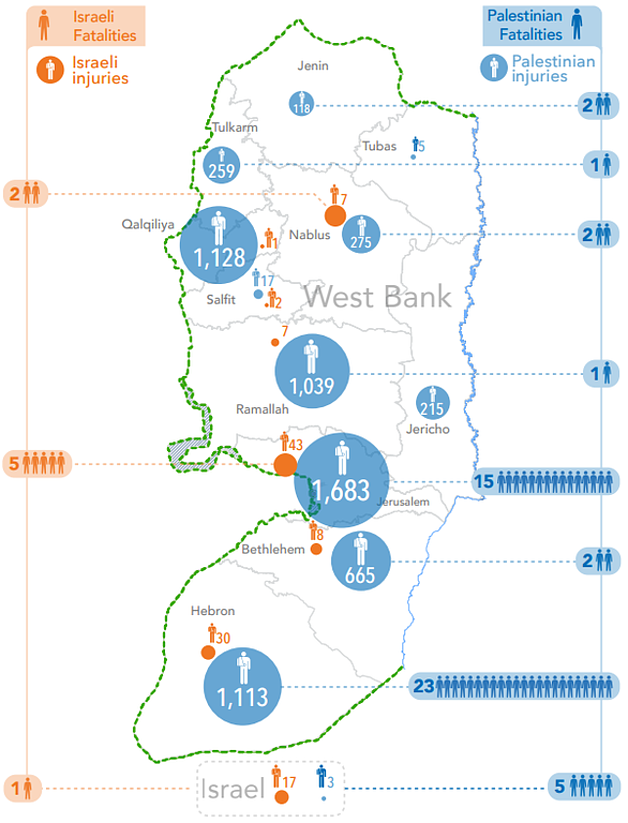
Concern over excessive use of force by Israeli forces: The high number of Palestinian deaths and injuries by Israeli security forces, particularly those resulting from the use of live ammunition, has underscored longstanding concerns about the excessive use of force in both violent protests and in dealing with stabbing or alleged stabbing attacks.
Initial evidence from some stabbing incidents, including video footage, suggests that the attackers could have been controlled and apprehended using a lesser degree of force.[3] Concerns are reinforced by quotes in the media by senior Israeli officials, including the Jerusalem District Police Commander and the Interior Security Minister, declaring that the perpetrators of attacks should not leave the scene of a crime alive.[4]
In the West Bank and in dealing with protests next to Gaza’s fence, Israeli forces act in a law enforcement capacity. Under international law, the use of firearms in law enforcement circumstances is only permitted in self-defence or in defence of others against imminent threat of death or serious injury, and only when less extreme means are insufficient to protect life.[5] The applicability of these principles vis-à-vis Israeli forces in the current context has been confirmed by the Israeli Attorney General.[6]
Although several investigations have reportedly been opened into deaths resulting from clashes in the West Bank,[7] the majority of cases involving the killing or serious injury of protestors, and perpetrators or alleged perpetrators of attacks, have not so far been subjected to investigation and the lack of accountability is a growing concern.
As noted by the UN Deputy Secretary-General in his briefing to the Security Council on 22 October, the rise in Palestinian protests and attacks is taking place against a background of growing frustration with the lack of a political horizon leading to an end to the longstanding Israeli occupation. Other factors generating frustration include concerns about changes to the status quo at the Haram Al Sharif/Temple Mount; continuous settlement expansion alongside severe constraints on Palestinian development in Area C; and a general lack of accountability regarding attacks against Palestinians.
[1] For further details on the initial incidents see OCHA, Protection of Civilians Weekly Report, 8 - 14 September 2015.
[2] The figures of Israeli casualties exclude those that occurred within Israel and did not involved Palestinians from the oPt as either victims or perpetrators.
[3] Statement by the UN High Commissioner for Human Rights at the Special Meeting of the Human Rights Council, available here.
[4] Jerusalem District Police Commander, Moshe Edri, said: “Anyone who stabs Jews or hurts innocent people is due to be killed”. (Walla News, 10 October 2015, in Hebrew). The Interior Security Minister, Gilad Erdan, declared: “Every terrorist should know that he will not survive the attack he is about to commit”.
[5] The basic rules on this issue derive from Article 6 of the International Covenant on Civil and Political Rights; Article 43 of the 1907 Hague Regulations; and are reflected in Principle 9 of the UN Basic Principles on the Use of Force and Firearms by Law Enforcement Officials.
[6] Letter from Attorney General Yehuda Weinstein to the Legal Centre for Minority Rights in Israel (Adalah), 26 October 2015. See also here.
[7] According to information provided to OCHA by B'Tselem, The Israeli Information Center for Human Rights.










